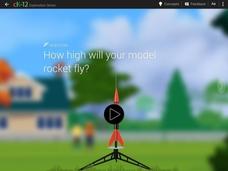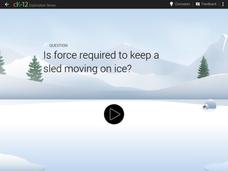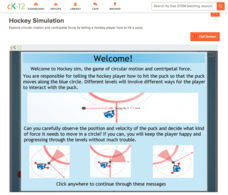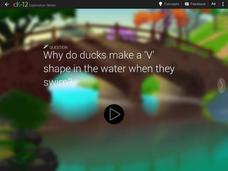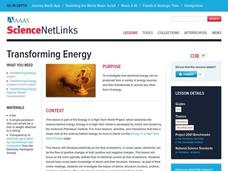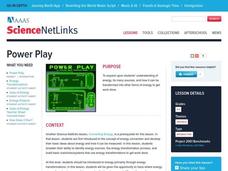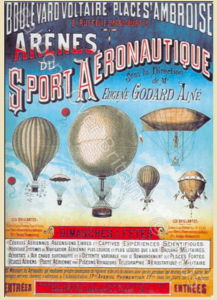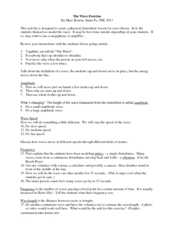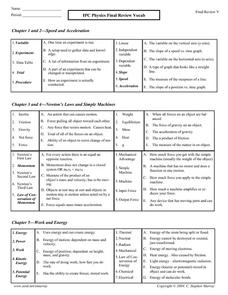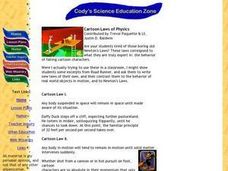CK-12 Foundation
Orbital Motion
Why do planets orbit the sun in ellipses when moons orbit their planet in circles? Pupils control the semi-major axis, eccentricity of the orbit, and position angle. The resulting orbital appears with the related force vectors as...
CK-12 Foundation
Model Rocket
Acceleration, velocity, mass, and gravity all play a role in the motion of a rocket. Young scientists explore the connection among these components using an interactive tutorial. They adjust the mass and thrust force to experiment with...
CK-12 Foundation
First Law Simulation
Does Newton's First Law of Motion explain how to move a sled across ice? A simulation encourages scholars to decide if they should push, pull, or apply no force. Their decision moves a sled across the ice and to the home at the...
CK-12 Foundation
Hockey Simulation
Do you understand the science behind hitting a hockey puck to control the direction it moves? Pupils experiment by telling a hockey player how to hit the puck so it moves in a circular direction. Through manipulating the velocity and...
CK-12 Foundation
Doppler Ducks
The study of waves is not a quacking matter! Watch as a duck manipulates the behavior of its waves through its motion. Graphs show the frequency and wavelength of the waves.
Curated OER
Transforming Energy
Super detailed, this lesson will educate physical science learners about the flow of electrons. Begin by reviewing potential and kinetic energy with a moving pendulum, and then get them online to observe interactive websites about...
Curated OER
Power Play
Once your physical science stars have a grasp of the different forms of energy, use this resource to get them putting the energy to work. Small groups choose from seven different project options and work together to build an energy...
Urbana School District
Gravitation
Introduction your class to famous astronomers with a presentation that also covers Newton's Laws of Gravitation, Kepler's Laws of Planetary Motion, both uniform and nonuniform gravitational fields, and how to calculate the gravitational...
Exploratorium
Diamagnetism
If you are attracted to activities dealing with diamagnetism, here is a rare find that you will appreciate. With a neodymium magnet and a few common materials, move a pair of juicy grapes without touching them. Though the fruit is...
Science Geek
Gas Laws
A physical science presentation begins with an explanation of ideal gases and their behavior. Then it introduces all of the gas laws with descriptions and formulas.
CK-12 Foundation
Bobsled
Bobsled riders' safety depends on skill ... and physics! Learners use a simulation to understand the physics behind the sport. They manipulate the speed, mass, and/or turn radius of the sled and watch the effects on the centripetal force.
The Science Spot
The Wave Exercise
During a lesson on wave motion, physical science participants basically act out the waves as a group. Through their movements, the amplitude, speed, frequency, and wavelength are all identified. Ideas for modeling the reflection and...
Institute of Electrical and Electronics Engineers
Trebuchet Toss
Young engineers work in teams to design and build their own trebuchets according to certain criteria; they must be able to launch a mini marshmallow accurately into a pie tin. Background reading material, a planning sheet for trebuchet...
Berkeley Engineering and Mentors
Marshmallow Catapaults
After a brief lecture on levers, torque, projectiles, and the five-step engineering design cycle, young physical science learners or engineers build catapults out of craft sticks. This is an open-ended exploration of what works and what...
Weebly
Definitions of Conduction, Convection, and Radiation
There's quite a bit in this physical science packet. First, how is heat transferred? Learners read a brief explanation of conduction, convection, and radiation before identifying common occurrences (with pictures) as one of the three....
Curated OER
The Physics of Skateboarding
High schoolers are able to analyze gravity as an universal force. They are able to determine how the force of friction retards motion. Students are able to apply Newton's Laws of Motion ot the way the world works.
Curated OER
The Physics of Skateboarding
Students explore Newton's three laws, gravity, momentum, trajectory, projectiles, circular motion, and friction by observing and breaking down skateboard tricks. They view short video clips of Tony Hawk and explain the physics concepts...
Curated OER
Projectile Motion
Students observe projectile motion and calculate the speed of a baseball based on the time and distance traveled. They record the time, measure the distance, and draw the path of the ball's travel on a data table.
Curated OER
IPC Physics Vocabulary Review
In this physics review instructional activity, students review vocabulary words associated with speed, acceleration, Newton's Laws and simple machines, work and energy, magnetism, electricity, and harmonic motion and light. This...
Curated OER
Cartoon Laws of Physics
High schoolers are introduced to Newton's Laws. They are shown excerpts from Road Runner, and students are asked to write new laws of their own, and then constrast them to the behavior of real world objects in motion, and to Newton's...
Curated OER
Linear Motion
In this fantastic physics and math lesson, student pairs create a ramp that will transport a rolling marble in order to learn about linear motion. Students use cardboard, straws, toothpicks, marshmallows, and paper clips in order to make...
Curated OER
Newton's Laws of Motion
In this physics learning exercise, students examine Newton's Laws of Motion by completing 4 different mini labs and answering follow-up questions for each lab.
Curated OER
Physics: Bounce - Projectile Motion and Collisions
Students conduct and observe experiments in Newtonian mechanics, kinematics, and projectile motion. They analyze the motion of a ball rolling off a table, falling, and then bouncing. Students answer a series of questions analyzing the...
Curated OER
IPC Physics
In this physics review learning exercise, students compare inertia and momentum, insulators and conductors, and series and parallel circuits. Students review Newton's laws. This learning exercise has 20 fill in the blank, 12 matching,...



